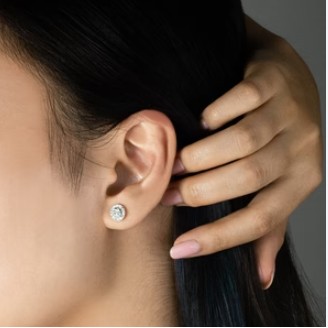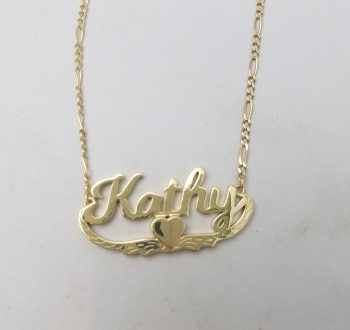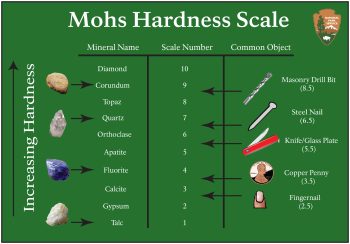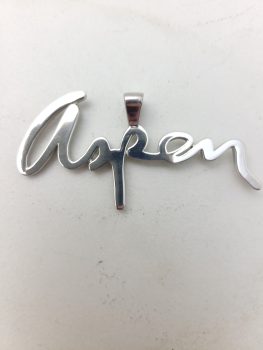Diamond Shapes
Diamond Shapes are a science as well as an art. The round brilliant cut has 57 facets, and it was not by accident that that number was chosen. Much thought, the studying of angles, and trial and error went into what we call a round diamond. And the round brilliant cut wasn’t even invented until 1919. So, diamond cutting, while an ancient art, is still evolving with as our technology does. It is the different cuts of diamonds that has given us so many ways to enjoy the beauty these stones have.
In this post, we will discuss the most popular diamond shapes: The RBC, Oval, Princess, Pear, Asscher, Cushion, and Emerald. We will also discuss the “fancy” diamond cuts such as the half moon, trapezoid, or heart shapes. Each of these diamond cuts is a feat in its own right. They each have a unique history, attributes, and pros and cons.
Whether you love the classic round cut or the trendy asscher cut, hopefully you will be a little better informed about diamond shapes after reading this. Also, we are going to assume that you already have a basic knowledge of the 4 C’s. If not, you can read that post from the standard of diamond grading.
Round Brilliant Cut Diamonds
Round Brilliant Cut Diamonds are one of the most popular diamond shapes in the world. They are known for their exceptional sparkle and brilliance. The round shape of these diamonds allows for maximum light reflection, resulting in a stunning display of fire and scintillation. This cut is also versatile, as it can be used in various jewelry designs, from engagement rings to earrings and necklaces.
Round Brilliant Cut Diamonds have a rich and fascinating history. The origins of this popular diamond cut can be traced back to the 17th century. It was during this time that diamond cutters began experimenting with different ways to maximize the brilliance and sparkle of diamonds. The Round Brilliant Cut, with its 57 facets, was born out of these experiments in 1919.
The Round Brilliant Cut quickly gained popularity due to its ability to reflect light in a way that maximizes the diamond’s brilliance. This cut is known for its symmetrical shape and precise proportions, which allow for optimal light performance. Today, the Round Brilliant Cut is the most popular diamond cut, accounting for approximately 75% of all diamonds sold worldwide.
Over the years, advancements in technology and diamond cutting techniques have further enhanced the brilliance and fire of Round Brilliant Cut Diamonds. With the introduction of computer-aided design and laser cutting, diamond cutters are able to achieve even greater precision and consistency in the cutting process. This has resulted in diamonds that are more dazzling and captivating than ever before.
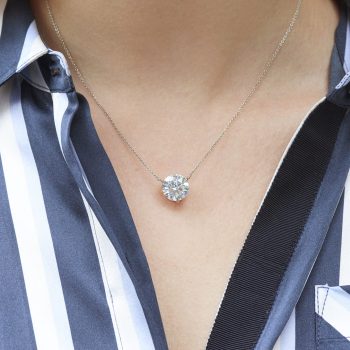
Oval Cut Diamonds
Oval cut diamonds have a rich history that dates back to the late 17th century. The shape of these diamonds is characterized by an elongated oval shape, with 56 to 58 facets that enhance their brilliance. The oval cut was first introduced by Lazare Kaplan in the early 1960s, and since then, it has gained popularity for its elegant and timeless appeal.
One of the main advantages of oval cut diamonds is their ability to create the illusion of longer, slender fingers when worn as a ring. This makes them a popular choice for engagement rings and other jewelry pieces. Additionally, the elongated shape of oval cut diamonds allows for a larger surface area, which maximizes the stone’s brilliance and fire.
Oval diamond shapes have been favored by many celebrities and royalty throughout history. Their versatility and classic beauty make them a timeless choice for those seeking a sophisticated and elegant look. Whether used as a center stone or as accent stones in a jewelry piece, oval cut diamonds continue to captivate and inspire with their unique charm and brilliance.
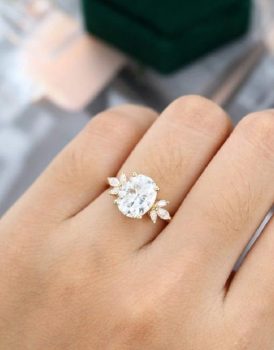
Princess Cut Diamonds
Princess cut diamonds have a rich history that dates back to the 1960s. This diamond cut was created by Arpad Nagy, a diamond cutter from London. Nagy wanted to develop a square-shaped diamond that would maximize the brilliance and sparkle of the stone. After years of research and experimentation, he successfully created the Princess cut, which quickly gained popularity in the jewelry industry.
The Princess cut is characterized by its square or rectangular shape with pointed corners. It is a modified brilliant cut, which means it has multiple facets that reflect light and create a dazzling display of brilliance. The cut is known for its versatility, as it can be used in various jewelry designs, from engagement rings to earrings and pendants.
One of the reasons why Princess cut diamonds became so popular is their modern and contemporary appeal. The clean lines and geometric shape of the cut make it a favorite choice for those who prefer a sleek and sophisticated look. Additionally, the Princess cut is known for its exceptional brilliance, as it maximizes the amount of light that enters the stone, resulting in a stunning display of sparkle.
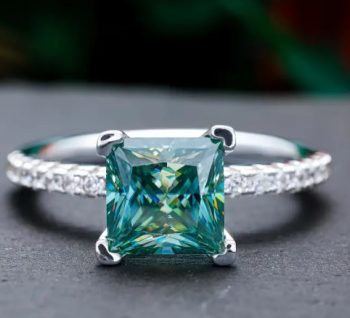
Pear Cut Diamonds
Pear cut diamonds have a rich history that dates back to the 15th century. This unique diamond shape, also known as the teardrop shape, was first introduced by Flemish diamond cutter Lodewyk van Berquem. The pear cut diamond quickly gained popularity due to its elegant and elongated shape, making it a favorite choice for engagement rings and other jewelry pieces.
One of the most notable features of pear diamond shapes is its versatility. It can be worn with the point facing up or down, allowing for different design options. The pear shape also has the ability to create the illusion of longer and slimmer fingers when worn as a ring.
Throughout history, pear cut diamonds have been favored by many celebrities and royalty. One of the most famous pear cut diamonds is the “Taylor-Burton Diamond,” a 69.42-carat pear-shaped diamond that was given to actress Elizabeth Taylor by her husband Richard Burton. This stunning diamond became a symbol of their love and remains one of the most iconic pear cut diamonds to this day.
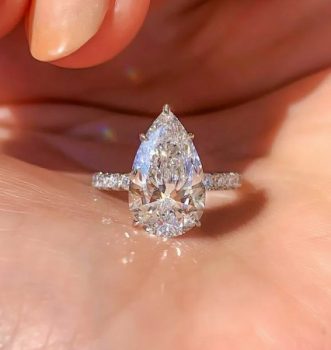
Asscher Cut Diamonds
Asscher cut diamonds have a rich history that dates back to the early 20th century. Named after its creator, Joseph Asscher, this unique diamond cut was first introduced in 1902. Asscher cut diamonds are known for their distinctive square shape with cropped corners, similar to an emerald cut.
Initially, Asscher cut diamonds gained popularity during the Art Deco period, as they perfectly embodied the geometric and symmetrical designs of the time. Their step-cut facets and high crown create a mesmerizing play of light and shadow, giving them a timeless elegance.
Over the years, Asscher cut diamonds have continued to captivate jewelry enthusiasts and collectors alike. Their vintage appeal and exceptional craftsmanship make them a sought-after choice for engagement rings and other fine jewelry pieces. Whether you’re looking for a classic and sophisticated look or a unique and eye-catching design, Asscher cut diamonds are sure to make a statement.
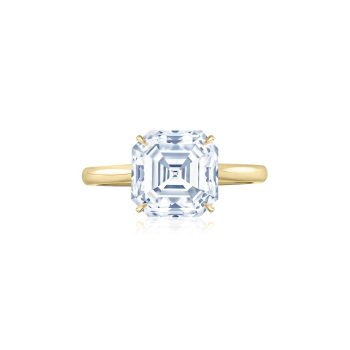
Cushion Cut Diamonds
Cushion cut diamonds are a popular choice for engagement rings. With their rounded corners and large facets, they offer a unique and elegant look. The cushion cut is known for its brilliance and fire, making it a great option for those who want a diamond that sparkles.
Cushion cut diamonds have a rich history that dates back to the 18th century. This particular diamond cut is known for its square or rectangular shape with rounded corners, resembling a cushion. It gained popularity during the Victorian and Edwardian eras, and continues to be a sought-after choice for engagement rings and other jewelry.
The cushion cut diamond was originally called the “old mine cut” due to its resemblance to the shape of rough diamonds found in old mines. It was one of the earliest diamond cuts, known for its large facets and high crown, which allowed for maximum brilliance and sparkle. This cut was particularly popular during the Georgian and Victorian eras, when diamonds were often set in intricate, ornate designs.
In the early 20th century, the cushion cut diamond underwent a transformation with the introduction of the “modern cushion cut.” This updated version featured a smaller table, larger facets, and a more defined shape. It became a popular choice during the Art Deco period, known for its geometric and symmetrical designs. Today, cushion cut diamonds are still highly regarded for their timeless elegance and versatility, making them a classic choice for those seeking a vintage-inspired look.
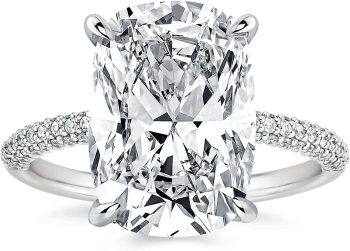
Emerald Cut Diamonds
Emerald cut diamonds have a rich history that dates back to the 16th century. This unique diamond shape is known for its rectangular or square shape with cut corners, and its step-cut faceting style. The emerald cut was originally developed for emeralds, hence the name, but its clean lines and elegant appearance quickly made it popular for diamonds as well.
One of the earliest examples of emerald cut diamonds can be traced back to the 1500s. The technique of cutting and polishing diamonds was still in its infancy back then. However, it wasn’t until the Art Deco period of the 1920s that the emerald cut truly gained popularity. The clean lines and geometric shape of the emerald cut perfectly complemented the sleek and modern aesthetic of the Art Deco movement.
Today, emerald cut diamonds continue to be a popular choice for engagement rings and other fine jewelry. Their elongated shape and large table facet make them appear larger than other diamond shapes of the same carat weight. Additionally, the step-cut faceting style of emerald cut diamonds creates a unique play of light and dark. This gives them a distinct and sophisticated look.
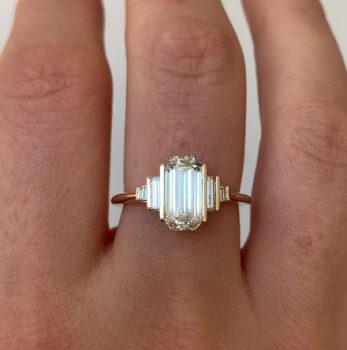
Fancy Cut Diamonds
Fancy cut diamonds are a popular choice among jewelry enthusiasts. These diamonds are known for their unique and intricate shapes, which set them apart from traditional round brilliant diamonds. The term “fancy cut” encompasses a wide range of diamond shapes, including half moon, trapezoid, and heart shapes. Each shape has its own distinct characteristics and appeal. Fancy cut diamonds offer a variety of options for those looking to add a touch of individuality and elegance to their jewelry collection.
Half moon cut diamonds are named after its shape, which resembles a half moon. The cut features a flat bottom and gently curved sides, creating a beautiful and symmetrical appearance. The half moon cut is often used as a side stone in engagement rings or as a focal point in earrings or pendants. Its versatility and timeless appeal make it a popular choice among jewelry enthusiasts.
Trapezoid cut diamonds are a unique and eye-catching choice for those looking for something different in their jewelry. With their distinct shape and elegant lines, trapezoid cut diamonds offer a modern and sophisticated look. These diamonds are characterized by their four sides, with the top and bottom sides parallel to each other and the two remaining sides slanting inward. This creates a trapezoid shape that sets them apart from traditional diamond cuts.
Heart cut diamonds are a popular choice for those seeking a unique and romantic engagement ring. This diamond shape is characterized by its distinctive heart shape, with a pointed tip and rounded lobes. The heart cut is a modified brilliant cut, which means it has a similar faceting pattern to the traditional round brilliant cut. This allows the heart cut diamond to exhibit exceptional brilliance and sparkle.
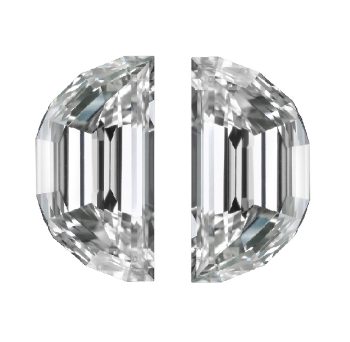
Pros & Cons
Round Brilliant Cut
Its symmetrical shape and numerous facets maximize the stone’s brilliance and sparkle. This cut is known for its versatility, as it can be used in a variety of jewelry settings. One of the main advantages of the Round Brilliant Cut is its ability to maximize the diamond’s brilliance. The numerous facets reflect light in a way that enhances the stone’s sparkle, making it appear more brilliant and radiant. This cut is designed to optimize the diamond’s fire and scintillation, creating a dazzling display of light.
Another advantage of the Round Brilliant Cut is its versatility. This cut can be used in a wide range of jewelry settings, from solitaire engagement rings to earrings and pendants. Its classic and timeless appeal makes it a popular choice for those looking for a traditional and elegant look.
However, there are also some cons to consider when choosing the Round Brilliant Cut. One drawback is that this cut tends to be more expensive compared to other diamond cuts. The complex faceting and precision required to create the Round Brilliant Cut can increase the cost of the diamond. Additionally, the round shape can also result in more diamond wastage during the cutting process.
Oval Cuts
One of the main advantages of an oval cut diamond is its versatility. The elongated shape of the diamond makes it appear larger than other cuts of the same carat weight. This means you can get a bigger looking diamond for your budget. Additionally, the oval shape is flattering on many different hand shapes and sizes, making it a great choice for a wide range of people.
Another advantage of oval cut diamonds is their brilliance. The faceting pattern of the oval cut allows for maximum light reflection, resulting in a diamond that sparkles and shines.
However, there are also some cons to consider when it comes to oval cut diamonds. One potential drawback is that the elongated shape can make the diamond more prone to chipping and breaking. Another potential downside to oval cut diamonds is that they can sometimes exhibit a “bow-tie” effect. This is a dark area that appears in the center of the diamond, resembling a bow tie. While not all oval cut diamonds have this effect, it’s something to be aware of when choosing a stone.
Princess Cuts
One of the main advantages of the princess cut diamond is its exceptional brilliance. The way the diamond is cut allows for maximum light reflection, resulting in a stunning sparkle that catches the eye. Additionally, the princess cut is known for its versatility, as it can be set in various styles of engagement ring settings, from solitaire to halo designs.
On the other hand, one of the drawbacks of the princess cut diamond is its vulnerability to chipping. The pointed corners of the diamond can be more prone to damage compared to other diamond shapes. It is important to choose a setting that provides adequate protection for the corners of the diamond to minimize the risk of chipping.
Pear Cuts
One of the main advantages of the pear cut diamond is its versatility. The elongated shape of the stone can create the illusion of longer, more slender fingers when worn as a ring. Additionally, the pear cut diamond can be set in a variety of styles, from solitaire to halo settings, allowing for personalization and customization.
Another advantage of the pear cut diamond is its brilliance and sparkle. The shape of the stone, with its combination of a rounded end and a pointed end, allows for maximum light reflection and refraction. This results in a diamond that appears larger and more radiant than other cuts of the same carat weight.
However, there are also some considerations to keep in mind when choosing a pear cut diamond. One potential drawback is the vulnerability of the pointed end. This part of the stone is more prone to chipping and damage compared to other cuts. It is important to choose a setting that protects the pointed end and to handle the diamond with care.
Asscher Cuts
One of the main advantages of the Asscher Cut is its elegance and sophistication. The step-cut facets create a mesmerizing play of light, giving the diamond a timeless beauty. Additionally, the Asscher Cut is versatile and can be set in various styles, from classic solitaires to elaborate halo designs.
However, it’s important to note some potential drawbacks of the Asscher Cut. Due to its large table and step-cut facets, inclusions and color imperfections may be more visible compared to other diamond cuts. This means that choosing a higher clarity and color grade is crucial to ensure the diamond’s brilliance and overall appearance.
Cushion Cuts
One of the main advantages of a cushion cut diamond is its versatility. The shape of the diamond allows for a range of different proportions, which means that you can find a cushion cut diamond that suits your personal style and preferences. Additionally, cushion cut diamonds tend to have a larger face-up appearance compared to other diamond shapes of the same carat weight, giving them a more substantial look.
However, it’s important to note that cushion cut diamonds can also have some drawbacks. One potential con is that cushion cut diamonds tend to show more color than other diamond shapes. This means that if you are looking for a diamond with a higher color grade, you may need to choose a higher grade for a cushion cut diamond compared to a round or princess cut diamond.
Emerald Cuts
One of the main advantages of emerald cut diamonds is their (typical) exceptional clarity. Due to their long, rectangular facets, these diamonds tend to showcase the clarity of the stone more prominently than other diamond cuts. This means that even with lower grades of clarity, emerald cut diamonds can still appear stunningly clear and eye-catching.
Another advantage of emerald cut diamonds is their versatility. This diamond shape looks beautiful in a variety of settings. Whether it’s a solitaire ring, a three-stone setting, or even in a halo design. The elongated shape of the emerald cut also creates the illusion of longer, more slender fingers. This makes it a popular choice among those who want to create a flattering and elegant look.
However, it’s important to consider the cons of emerald cut diamonds as well. One of the main drawbacks is their vulnerability to visible inclusions. Due to the large, open table and step-cut facets, any flaws or inclusions within the diamond can be more easily visible compared to other diamond cuts. This means that if you prioritize a flawless appearance, you may need to choose a higher clarity grade for an emerald cut diamond.
Additionally, emerald cut diamonds may not have the same level of brilliance and sparkle as other diamond shapes, such as round brilliant cuts. The step-cut facets of emerald cut diamonds reflect light differently, resulting in a more subtle and understated sparkle. If you prefer a diamond with maximum brilliance and fire, you may want to consider other diamond shapes.
We Create Custom Jewelry
That means that any interguing rings, earrings, and custom pendants etc, is made from the ground up just for you. It also means that any stones will be sourced specifically for your piece.
So, take a look at our portfolio and then contact us with your idea.

